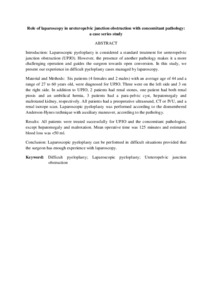Citation
Fahmy, Omar and El-Fayoumi, Abdel Rahman and Gakis, Georgios and Amend, Bastian and Mohd Ghani @ Mamat, Khairul Asri and Stenzl, Arnulf and Schwentner, Christian
(2015)
Role of laparoscopy in ureteropelvic junction obstruction with concomitant pathology: a case series study.
Central European Journal of Urology, 68 (4).
pp. 466-470.
ISSN 2080-4806; ESSN: 2080-4873
Abstract
INTRODUCTION:
Laparoscopic pyeloplasty is considered a standard treatment for ureteropelvic junction obstruction (UPJO). However, the presence of another pathology makes it a more challenging operation and guides the surgeon towards open conversion. In this study, we present our experience in difficult pyeloplasty cases managed by laparoscopy.
MATERIAL AND METHODS:
Six patients (4 females and 2 males) with an average age of 44 and a range of 27 to 60 years old, were diagnosed for UPJO. Three were on the left side and 3 on the right side. In addition to UPJO, 2 patients had renal stones, one patient had both renal ptosis and an umbilical hernia, 3 patients had a para-pelvic cyst, hepatomegaly and malrotated kidney, respectively. All patients had a preoperative ultrasound, CT or IVU, and a renal isotope scan. Laparoscopic pyeloplasty was performed according to the dismembered Anderson-Hynes technique with auxiliary maneuver, according to the pathology.
RESULTS:
All patients were treated successfully for UPJO and the concomitant pathologies, except hepatomegaly and malrotation. Mean operative time was 125 minutes and estimated blood loss was <50 ml.
CONCLUSIONS:
Laparoscopic pyeloplasty can be performed in difficult situations provided that the surgeon has enough experience with laparoscopy.
Download File
![[img]](http://psasir.upm.edu.my/46205/1.hassmallThumbnailVersion/Role%20of%20laparoscopy%20in%20ureteropelvic%20junction%20obstruction%20with%20concomitant%20pathology%20a%20case%20series%20study.pdf)  Preview |
|
Text (Abstract)
Role of laparoscopy in ureteropelvic junction obstruction with concomitant pathology a case series study.pdf
Download (6kB)
| Preview
|
|
Additional Metadata
Actions (login required)
 |
View Item |

